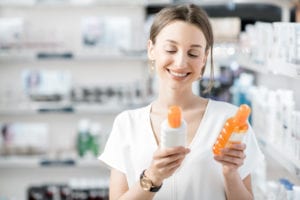Physical vs. Chemical Sunscreens
- Posted on: Sep 15 2018
- Leave a response
 Even in light of advanced skin cancer treatments, it is safe to say that doctors would much prefer if more people could avoid cancerous lesions altogether. For this to become a reality, it is vital that we educate ourselves on the ways that sunscreen products work. Most people will and cannot stay out of the sun altogether, so workable solutions are needed, and our patients need to know what those are.
Even in light of advanced skin cancer treatments, it is safe to say that doctors would much prefer if more people could avoid cancerous lesions altogether. For this to become a reality, it is vital that we educate ourselves on the ways that sunscreen products work. Most people will and cannot stay out of the sun altogether, so workable solutions are needed, and our patients need to know what those are.
Healthcare professionals know that patients should wear sunscreen. We may even have a basic working knowledge of their action on the skin. Here, we discuss an easy way to express this to patients who may be inadvertently putting their skin at risk.
Chemical Sunscreen
How It Works
Chemical sunscreens work by causing a chemical reaction on the skin when exposed to UV light. This mechanism is critical to know because it can create issues for certain people. The response of chemical sunscreen is created with some type of carbon-based compound. Typical ingredients include avobenzone, octisalate, and octinoxate. Some of these ingredients have been banned in Hawaii due to their adverse effect on coral beds, a detail that many people are not aware of.
Pros:
- A wide range of formulations, none of which leave streaks or residue on the skin.
- Broad-spectrum protection in a range of SPF.
- Adequate coverage can be achieved with less product.
Cons:
- Chemical sunscreen super-heats the skin, which can contribute to sunspots.
- If dryness and cracking compromise the protective skin barrier, chemical sunscreen may cause irritation.
- Reapplication is critical for ongoing protection.
Physical Sunscreen
Physical sunscreens are a literal protective barrier created by titanium oxide or zinc oxide. There is no chemical reaction within the skin; no heating of skin cells. The protective barrier causes UV light to deflect away from the skin.
Pros:
- Broad-spectrum protection from both UVA and UVB light.
- The physical barrier is immediately effective. It can also last longer.
- Appropriate for individuals with rosacea and other conditions that flare up with heat.
Cons:
- Most physical sunscreens are visible (though some contain pigment to make them more discreet).
- Reapplication is necessary if the physical sunscreen gets wet with sweat or water.
- Only areas that are covered will be protected. Missing a spot means susceptibility to sun damage. A generous application is necessary to achieve adequate coverage.
The American Society for Mohs Surgery is committed to ongoing education that enables healthcare providers to personalize treatment for each patient. To learn more about membership and upcoming courses, call (800) 616-2767.
Posted in: Skin Cancer, Skin Care


